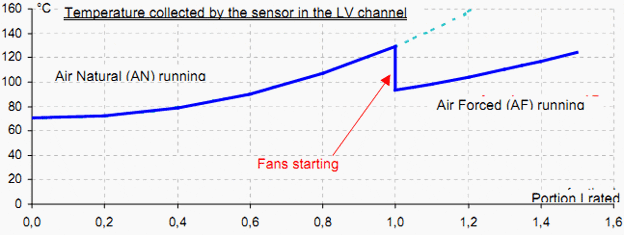
Transformers, when in operation, are subject to no-load losses and load losses. This energy causes a rise in the temperature of the transformer’s active part, i.e. the magnetic core and the windings. It is therefore normal for the transformer to be “hot” while it is running. This heating is taken into account when the equipment is designed and is, moreover, standardised.
At the customer’s request, fans can be installed beneath the Trihal windings to alleviate excessive heating caused by abnormal operating and/or installation conditions. This request must be made when the order is placed, as it is not always possible to act once the transformer has been installed on site.
Why install fans?
If fans are installed, the transformer can be overloaded without overheating. This overloading can be caused by: [fancy_header]1. The ambient temperature around the transformer[/fancy_header] In a poorly-ventilatedroom, where the ambient temperature exceeds normative values over a short period of time, fans can be used to punctually cool down the transformer. The ambient temperature problem will not be solved, but the punctual operation of the fans will stop the heat protection system from starting up and bringing the transformer to a halt. [fancy_header]2. The through-current or the voltage applied to the transformer[/fancy_header] It is important to understand that load losses are proportional to the square of the through-current. It is sometimes necessary to increase the load of the transformer for short periods, without having to oversize the transformer when it is designed, because it will not have to withstand this overload permanently. Fans keep the temperature of the transformer below standardised limits, so that the power of the transformer can be increased without shortening its service life.
Sizing the transformer
The transformer is therefore sized to permanently maintain:
- its nominal output
- at nominal ambient temperature, in a naturally ventilated room, i.e. without fans.
The flow rate of the fans, which has a direct influence on their size, is determined according to the overload specified by the customer. On site, as soon as the load or the ambient temperature becomes excessive, the fans start up to stop the temperature from climbing as a result of the overload.
Heat protection
This is based on the following:
- temperature sensors, which are placed at the hottest points on each column of the active part; they are serially connected and their resistance increases significantly if any of them is exposed to the maximum temperature authorised;
- an electronic converter, which permanently monitors the resistance of these sensors ; if it detects an excessive level of resistance, it switches a contact to give an order;
- 2 tangential fan ramps, which are fixed to either side of each column and start up on receiving an order from the converter via the relays. They blow ambient air into the windings.
This protection system is sized for permanently-running transformers in nominal operating conditions. Therefore, the fans are not continuously working, and stop as soon as the temperature has dropped well below the alarm threshold. At nominal output, the alarm threshold is activated by the daily ambient temperature (30°C if the order specifies a maximum ambient temperature of 40°C) and the tripping threshold is activated by the maximum authorised ambient temperature (40°C if the order specifies a maximum ambient temperature of 40°C). At nominal output, the fans start up when the ambient temperature matches the annual ambient temperature (if the order specifies a maximum ambient temperature of 40°C) so that the alarm threshold is not activated before the fans come into operation. The fans continue to operate for 20 minutes after the temperature has dropped by 20°C. In practice, the temperature falls by more than 20°C (up to 50°C).
Transformer and fan operation
Whatever the degree of overload, the fans always operate at full power (in relation to the maximum overload specified by the customer).  The fans operate according to the duration and extent of the overload. Punctual overload: If the overload is punctual, the fans operate for around half an hour. Lasting overload: If the overload continues, the fans do not stop, as the temperature does not go down to the fan stop threshold. On the other hand, the following might happen if the fans are very powerful:
The fans operate according to the duration and extent of the overload. Punctual overload: If the overload is punctual, the fans operate for around half an hour. Lasting overload: If the overload continues, the fans do not stop, as the temperature does not go down to the fan stop threshold. On the other hand, the following might happen if the fans are very powerful:  The power of the fans is such that the temperature drops to the stop level. When the fans stop, the temperature climbs again, as the transformer is still overloaded. As soon as the tripping threshold is reached again, the fans start up again and the cycle continues indefinitely if the operating conditions are not changed. In this case, the transformer is subjected to very significant temperature cycles. This thermal shock frequency is not recommended for resin-moulded HV coils, as it can cause cracks in the solid insulating material. To avoid this problem, the fan tripping threshold should be reduced, and the time-lag lengthened.
The power of the fans is such that the temperature drops to the stop level. When the fans stop, the temperature climbs again, as the transformer is still overloaded. As soon as the tripping threshold is reached again, the fans start up again and the cycle continues indefinitely if the operating conditions are not changed. In this case, the transformer is subjected to very significant temperature cycles. This thermal shock frequency is not recommended for resin-moulded HV coils, as it can cause cracks in the solid insulating material. To avoid this problem, the fan tripping threshold should be reduced, and the time-lag lengthened.










